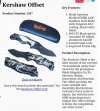- Joined
- Mar 18, 2020
- Messages
- 7
Dear all
I have received quite interesting sample of feedstock. I like to find some interested people to help with design of a potential product. This design can be very different from classic, because with 3d MIM - Technology we can do any geometry.
Differents of 440c is, that i have added some Niob for better performance of metal. This is used in Japan for special swords..
Regards
Andrej
I have received quite interesting sample of feedstock. I like to find some interested people to help with design of a potential product. This design can be very different from classic, because with 3d MIM - Technology we can do any geometry.
Differents of 440c is, that i have added some Niob for better performance of metal. This is used in Japan for special swords..
Regards
Andrej

